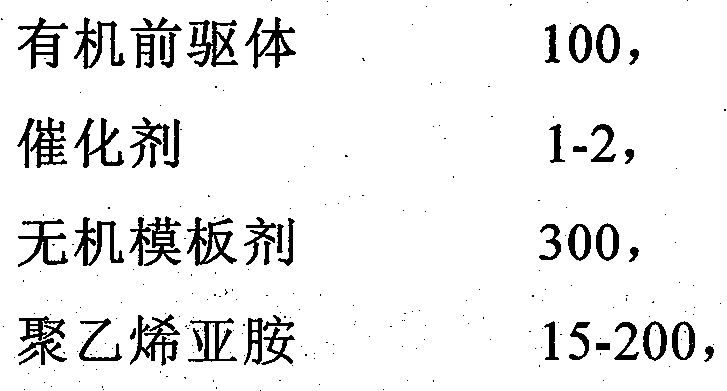Porous carbon composite material for adsorbing CO2 and preparation method and application thereof
A composite material and porous carbon technology, applied in the direction of adsorption, separation methods, chemical instruments and methods, etc., can solve the problems of poor adsorption selectivity, small adsorption capacity, and reduced carbon dioxide adsorption performance, and achieve good high-temperature adsorption effects.
- Summary
- Abstract
- Description
- Claims
- Application Information
AI Technical Summary
Problems solved by technology
Method used
Image
Examples
Embodiment 1
[0042] an adsorbed CO 2 Porous carbon composite material and its preparation method and application, the method comprises the following steps:
[0043](1) Sol-gel reaction: mix resorcinol and formaldehyde in 20g deionized water at a molar ratio of 1:2 to obtain an organic precursor, wherein resorcinol is 13g and formaldehyde is 7g, and the organic precursor is 0.2g sodium carbonate was added as a catalyst, and 50g of commercially available silica sol SM-30 was added thereto to obtain a mixture. The particle diameter of the silica sol was 7nm, and deionized water was added to control the content of the mixture to be 70g / 100g deionized water, place the mixture in a water bath at 85°C, and age for 3 days to obtain an organic-inorganic composite hydrogel;
[0044] (2) Solvent replacement and drying: Soak the organic-inorganic composite hydrogel in ethanol for 3 days, replace fresh ethanol every day, replace the solvent deionized water in the organic-inorganic composite hydrogel,...
Embodiment 2
[0049] an adsorbed CO 2 Porous carbon composite material and its preparation method and application, the method comprises the following steps:
[0050] (1) Sol-gel reaction: phenol, formaldehyde, and melamine are mixed in 30g deionized water in a molar ratio of 1:2:2 to obtain an organic precursor, wherein phenol is 10g, formaldehyde is 4.5g, and melamine is 5.5g. Add 0.2g sodium carbonate as catalyst in the organic precursor, then add 20g commercially available silica sol HS-30 thereinto, obtain mixture, the particle diameter of this silica sol is 12nm, replenish deionized water, control the The content is 40g / 100g deionized water, the mixture is placed in a water bath at 80°C, and aged for 2 days to obtain an organic-inorganic composite hydrogel;
[0051] (2) Solvent replacement and drying: Soak the organic-inorganic composite hydrogel in n-propanol for 2 days, replace fresh n-propanol every day, replace the solvent deionized water in the organic-inorganic composite hydroge...
Embodiment 3
[0056] an adsorbed CO 2 Porous carbon composite material and its preparation method and application, the method comprises the following steps:
[0057] (1) Sol-gel reaction: resorcinol, formaldehyde, melamine are mixed in 20g deionized water in molar ratio 1: 2: 1, obtain organic precursor, wherein resorcinol is 11g, and formaldehyde is 5g, Melamine 4g, in the organic precursor, add 0.4g sodium carbonate as catalyst, then add 60g commercially available silica sol SM-30 thereinto, obtain mixture, the particle diameter of this silica sol is 7nm, replenish deionized water , controlling the content of the mixture to be 80g / 100g deionized water, placing the mixture in a water bath at 80°C, and aging for 5 days to obtain an organic-inorganic composite hydrogel;
[0058] (2) Solvent replacement and drying: Soak the organic-inorganic composite hydrogel in ethanol for 3 days, replace fresh n-propanol every day, replace the solvent deionized water in the organic-inorganic composite hyd...
PUM
| Property | Measurement | Unit |
|---|---|---|
| pore size | aaaaa | aaaaa |
| pore size | aaaaa | aaaaa |
| pore size | aaaaa | aaaaa |
Abstract
Description
Claims
Application Information
 Login to View More
Login to View More - R&D
- Intellectual Property
- Life Sciences
- Materials
- Tech Scout
- Unparalleled Data Quality
- Higher Quality Content
- 60% Fewer Hallucinations
Browse by: Latest US Patents, China's latest patents, Technical Efficacy Thesaurus, Application Domain, Technology Topic, Popular Technical Reports.
© 2025 PatSnap. All rights reserved.Legal|Privacy policy|Modern Slavery Act Transparency Statement|Sitemap|About US| Contact US: help@patsnap.com

